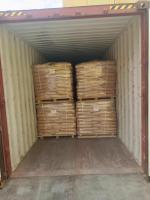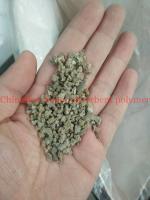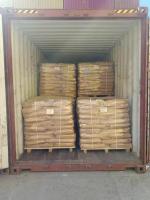Our Products
Product Center / super absorbent polymer(sap)used for baby diaper and lady sanitary pad

A superabsorbent resin is usually a polymer electrolyte with a hydrophilic and chemically crosslinked structure. Prior to hygroscopicity, the polymer material chains intertwine with each other and chemically cross-link to form a porous structure, thus achieving overall tightening. After contact with water, water seeps into the resin through capillary action and free diffusion to hydrolyze the functional groups in the resin chain. The chain of the polymer material is bent and dissolved due to electrostatic repulsion between the ions in the chain. By adjusting the charge balance, the counter-ions will not be transferred to the outside of the resin, and the difference in ion concentration between aqueous solutions in the external environment of the resin will produce the concentration of the reverse osmosis membrane. Under reverse osmosis concentration, water moves further into the resin to produce a gel.
Hygroscopic performance.
A superabsorbent resin is usually a polymer electrolyte with a hydrophilic and chemically crosslinked structure. Prior to hygroscopicity, the polymer material chains intertwine with each other and chemically cross-link to form a porous structure, thus achieving overall tightening. After contact with water, water seeps into the resin through capillary action and free diffusion to hydrolyze the functional groups in the resin chain. The chain of the polymer material is bent and dissolved due to electrostatic repulsion between the ions in the chain. By adjusting the charge balance, the counter-ions will not be transferred to the outside of the resin, and the difference in ion concentration between aqueous solutions in the external environment of the resin will produce the concentration of the reverse osmosis membrane. Under reverse osmosis concentration, water moves further into the resin to produce a gel.
In addition, the chemical cross-linked porous structure and hydrogen bonding of the resin itself limit the infinite expansion of the suspected glia.
When there is a small amount of acid salt in the water, the concentration of reverse osmosis decreases. In addition, due to the shielding effect of counter-ions, the polymer material chain collapses, greatly reducing the water absorption capacity of the resin. Generally speaking, the water absorption capacity of hyperabsorbent resin in 0.9% ammonium nitrate aqueous solution is only about 1/10 of that in double steam water.
Hygroscopicity and water lock are two aspects of a difficult problem, Lin Runxiong et al. The super absorbent resin can absorb water spontaneously under certain temperature and working pressure, and the water is introduced into the resin, so that the random enthalpy of each management system is reduced to equilibrium. If water escapes from the resin, the random enthalpy will rise, which is not conducive to the stability of the management system. Differential thermal analysis showed that 50 percent of the water digested and absorbed by the hyperabsorbent resin was still trapped in the Internet. So even if pressure is applied at room temperature, water will not escape from the superabsorbent resin, which is due to the thermal properties of the superabsorbent resin.
The main uses of hygroscopic polymers.
Superabsorbent polymers are widely used and have broad application prospects. At present, its application scope is still daily necessities, accounting for about 70% of the total production of the sales market. PAM super absorbent resin is widely used in agriculture, animal husbandry, forestry, fruit industry and other fields because of its strong water absorption capacity and good water locking performance. Adding a small amount of hyperabsorbent sodium polyacrylate into the soil layer can improve the emergence rate of some legumes and the drought resistance of soybean seedlings, and improve the permeability of soil layer. In addition,? Due to super water absorption resin, high quality anti-fogging mirror and anti-condensation performance, can be used as new packaging products. Film bags made of high absorbent polymers with various properties can effectively preserve food. Adding a small amount of super absorbent polymer can also increase the viscosity of moisturizing lotion, making it an ideal skin viscosifier. High absorbent polymer only absorbs water, does not take off the oil, does not take off the solvent, can be used in industrial production dehydrating agent.
Super absorbent resin.
With the development trend of science and technology, ecological environmental protection has been paid more and more attention. If a hyperabsorbent polymer is placed in a bag that dissolves waste water and the bag is permeated into the waste water, after the bag is melted, the hyperabsorbent polymer can quickly digest and absorb the liquid, allowing the waste water to solidify.
Superabsorbent polymers can also be used as temperature sensors, precise humidity measurement sensors and water leakage detectors in the electronics industry. Hyperabsorbent polymers can be used as raw materials for heavy metal ion adsorption and oil removal.A superabsorbent resin is usually a polymer electrolyte with a hydrophilic and chemically crosslinked structure. Prior to hygroscopicity, the polymer material chains intertwine with each other and chemically cross-link to form a porous structure, thus achieving overall tightening. After contact with water, water seeps into the resin through capillary action and free diffusion to hydrolyze the functional groups in the resin chain. The chain of the polymer material is bent and dissolved due to electrostatic repulsion between the ions in the chain. By adjusting the charge balance, the counter-ions will not be transferred to the outside of the resin, and the difference in ion concentration between aqueous solutions in the external environment of the resin will produce the concentration of the reverse osmosis membrane. Under reverse osmosis concentration, water moves further into the resin to produce a gel.
super absorbent polymer(sap)used for baby diaper and lady sanitary pad
.jpg)
Hygroscopic performance.
https://youtube.com/shorts/_f_CyOm2FV4
A superabsorbent resin is usually a polymer electrolyte with a hydrophilic and chemically crosslinked structure. Prior to hygroscopicity, the polymer material chains intertwine with each other and chemically cross-link to form a porous structure, thus achieving overall tightening. After contact with water, water seeps into the resin through capillary action and free diffusion to hydrolyze the functional groups in the resin chain. The chain of the polymer material is bent and dissolved due to electrostatic repulsion between the ions in the chain. By adjusting the charge balance, the counter-ions will not be transferred to the outside of the resin, and the difference in ion concentration between aqueous solutions in the external environment of the resin will produce the concentration of the reverse osmosis membrane. Under reverse osmosis concentration, water moves further into the resin to produce a gel.
In addition, the chemical cross-linked porous structure and hydrogen bonding of the resin itself limit the infinite expansion of the suspected glia.
When there is a small amount of acid salt in the water, the concentration of reverse osmosis decreases. In addition, due to the shielding effect of counter-ions, the polymer material chain collapses, greatly reducing the water absorption capacity of the resin. Generally speaking, the water absorption capacity of hyperabsorbent resin in 0.9% ammonium nitrate aqueous solution is only about 1/10 of that in double steam water.
Hygroscopicity and water lock are two aspects of a difficult problem, Lin Runxiong et al. The super absorbent resin can absorb water spontaneously under certain temperature and working pressure, and the water is introduced into the resin, so that the random enthalpy of each management system is reduced to equilibrium. If water escapes from the resin, the random enthalpy will rise, which is not conducive to the stability of the management system. Differential thermal analysis showed that 50 percent of the water digested and absorbed by the hyperabsorbent resin was still trapped in the Internet. So even if pressure is applied at room temperature, water will not escape from the superabsorbent resin, which is due to the thermal properties of the superabsorbent resin.
The main uses of hygroscopic polymers.
Superabsorbent polymers are widely used and have broad application prospects. At present, its application scope is still daily necessities, accounting for about 70% of the total production of the sales market. PAM super absorbent resin is widely used in agriculture, animal husbandry, forestry, fruit industry and other fields because of its strong water absorption capacity and good water locking performance. Adding a small amount of hyperabsorbent sodium polyacrylate into the soil layer can improve the emergence rate of some legumes and the drought resistance of soybean seedlings, and improve the permeability of soil layer. In addition,? Due to super water absorption resin, high quality anti-fogging mirror and anti-condensation performance, can be used as new packaging products. Film bags made of high absorbent polymers with various properties can effectively preserve food. Adding a small amount of super absorbent polymer can also increase the viscosity of moisturizing lotion, making it an ideal skin viscosifier. High absorbent polymer only absorbs water, does not take off the oil, does not take off the solvent, can be used in industrial production dehydrating agent.
Super absorbent resin.
With the development trend of science and technology, ecological environmental protection has been paid more and more attention. If a hyperabsorbent polymer is placed in a bag that dissolves waste water and the bag is permeated into the waste water, after the bag is melted, the hyperabsorbent polymer can quickly digest and absorb the liquid, allowing the waste water to solidify.
Superabsorbent polymers can also be used as temperature sensors, precise humidity measurement sensors and water leakage detectors in the electronics industry. Hyperabsorbent polymers can be used as raw materials for heavy metal ion adsorption and oil removal.





